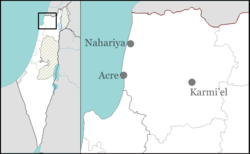Shlomi, Israel
Shlomi
| ||
|---|---|---|
| Hebrew transcription(s) | ||
| • ISO 259 | Šlomi | |
| • Also spelled | Shelomi (official) | |
 | ||
| ||
 Shlomi | ||
| Coordinates: 33°4′28.25″N 35°8′41.48″E / 33.0745139°N 35.1448556°ECoordinates: 33°4′28.25″N 35°8′41.48″E / 33.0745139°N 35.1448556°E | ||
| District | Northern | |
| Founded | 1950 | |
| Government | ||
| • Type | Local council | |
| • Head of Municipality | Gabi Naaman | |
| Area | ||
| • Total | 5,868 dunams (5.868 km2 or 2.266 sq mi) | |
| Population (2015)[1] | ||
| • Total | 6,172 | |
Shlomi (Hebrew: שְׁלוֹמִי) is a town in the Northern District of Israel. In 2015 it had a population of 6,172.
History
Shlomi was founded as a development town in 1950 by Jewish immigrants from Tunisia and Morocco on the ruins of a Arab village of al-Bassa, which had been destroyed during the 1948 Arab–Israeli War.[2][3][4] It was named after a leader from the tribe of Asher, mentioned in the Bible (Num 34:27).
Shlomi is supported in the main by the UJIA (United Jewish Israel Appeal), and by the British Jewish youth group, AJ6.
Shlomi has been the target of Hezbollah Katyusha rocket attacks on 11 May 2005, Israel's Independence Day, and again on Israel's Independence Day in 2006.
It was again the target of rocket attacks on 12 July 2006, a diversion to facilitate the killing of three soldiers and kidnapping two others, which sparked the 2006 Lebanon War.
References
- ↑ "List of localities, in Alphabetical order" (PDF). Israel Central Bureau of Statistics. Retrieved 16 October 2016.
- ↑ Benvenisti, Meron (2002). Sacred landscape: the buried history of the Holy Land since 1948. University of California Press. p. 193. ISBN 978-0-520-23422-2.
- ↑ Morris, Benny (2004). The Birth of the Palestinian Refugee Problem Revisited. Cambridge University Press. p. 253. ISBN 978-0-521-00967-6.
- ↑ "History of Shlomi".
External links
| Wikimedia Commons has media related to Shlomi. |
- History of Shlomi (Hebrew)
